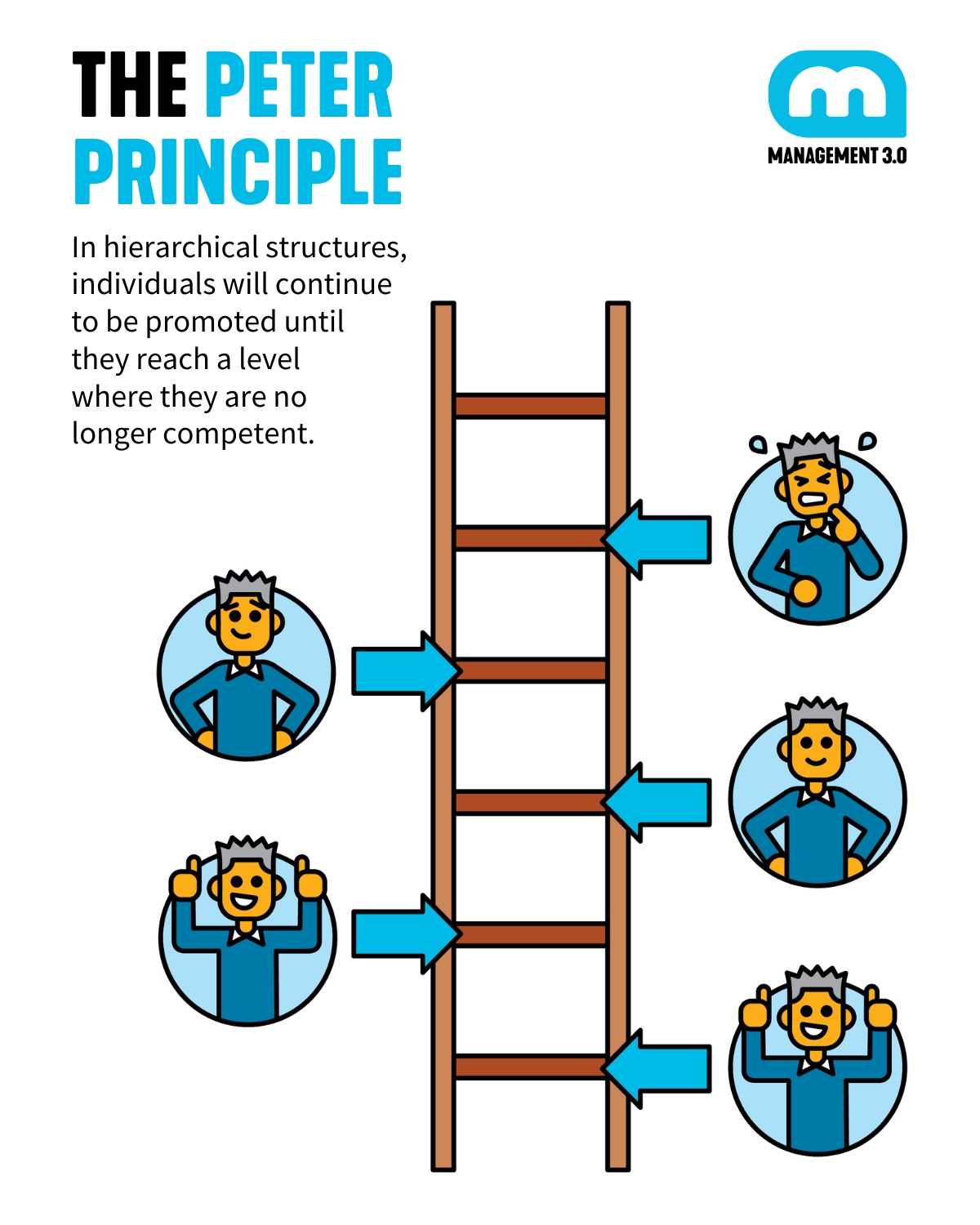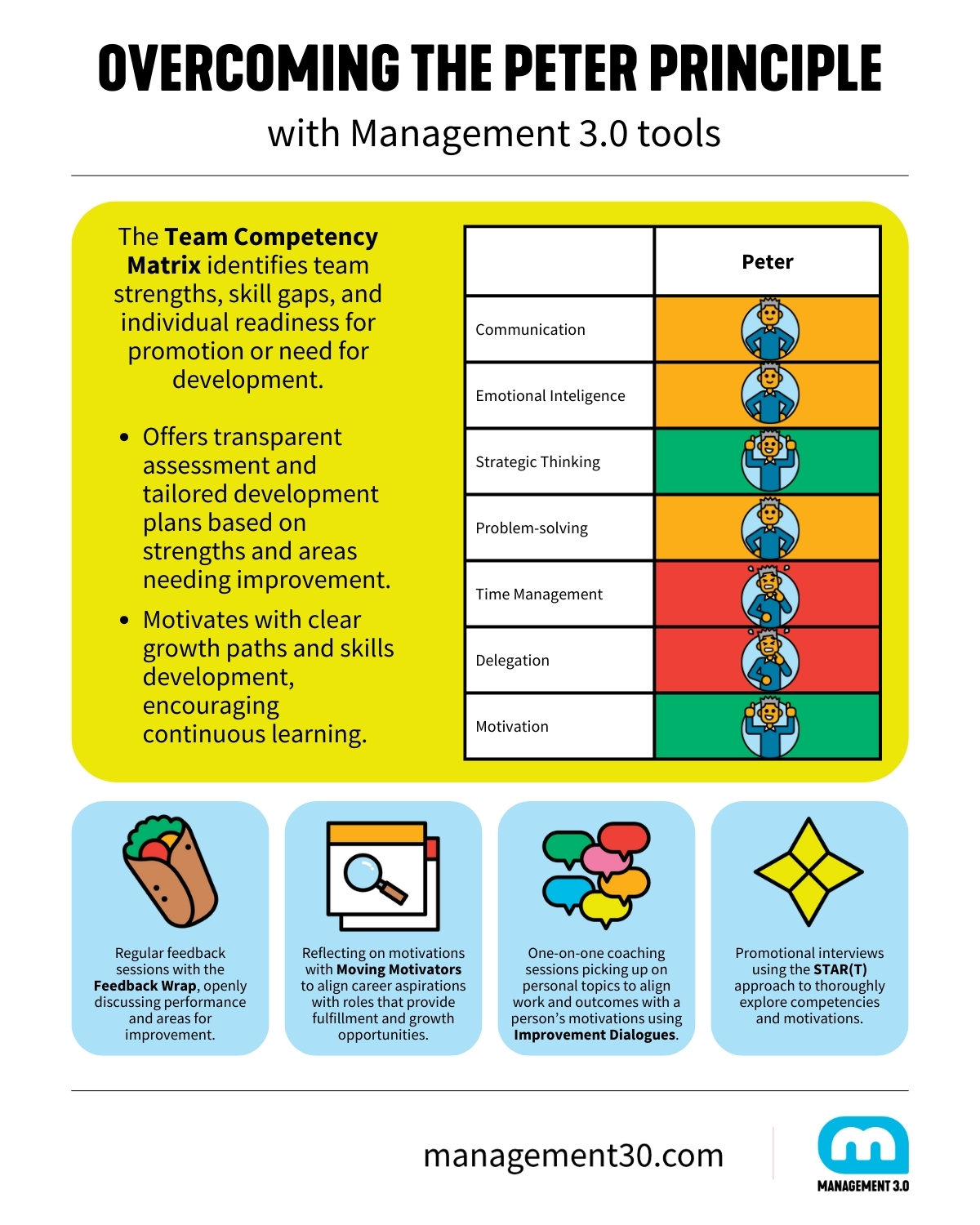By Juan Mello, a Management 3.0 Facilitator from Uruguay and an Agile Coach with over 15 years of experience in the Technology Industry. Juan has a deep passion for training, coaching, and facilitating, particularly for Agile Coaches, Scrum Masters, Team Leads, and Agile Leads. He is keenly aware of challenges like the Peter Principle, ensuring development aligns competencies with promotions effectively.
Have you ever wondered how someone ends up in a role they seem entirely unsuited for?
I’ve often heard remarks like, “How did they get that job? They don’t seem to know what they’re doing,” or “Why were they promoted to that position?” I remember pondering these comments myself, and I always found it fascinating how certain events unfolded until a particular person ended up in a role that seemed completely mismatched.
It wasn’t until I had a coffee conversation and learned about “Peter’s Principle” that it all made sense. Sometimes, labeling things can be helpful.
This article is for all of you who ask yourselves the same questions, who are baffled and shaking your heads in disbelief. It’s for all of you who can find comfort knowing that this phenomenon affects many people.
- What is the Peter Principle?
- The Individual Effects of the Peter Principle
- The Business Effects of the Peter Principle
- How to Overcome or Even Avoid the Peter Principle
What is the Peter Principle?
In hierarchical structures, individuals will continue to be promoted until they reach a level where they are no longer competent, leading to inefficiency and frustration within the organization.
The Peter Principle, conceived by Laurence J. Peter and Raymund Hull and explained in their 1969 book “The Peter Principle,” highlights a common phenomenon in hierarchical organizations. Essentially, it observes that individuals working in a hierarchical structure tend to be promoted based on their performance in their current roles rather than their competence for the intended promotion.
As people succeed in their current positions, they are often rewarded with promotions to higher levels within the organization. However, the crucial point of the Peter Principle is that this promotion process doesn’t always consider whether the skills required for the new role align with the individual’s capabilities. Consequently, individuals may eventually reach a level where they are no longer competent because the skills that made them successful in their previous roles may not translate effectively to the demands of the new position – and this goes the majority of people.
In a hierarchy, every employee tends to rise to his level of incompetence.
Laurence J. Peter, Raymond Hull
As per the Peter Principle, over time, as promotions continue within the organization, positions may become occupied by individuals who are not adequately equipped to fulfill their duties.

Let’s look at two concrete examples to understand the Peter Principle better:
First, we have Jane, a highly skilled software developer. Jane excels in her role, consistently delivering high-quality code and innovative solutions. Because of her outstanding performance, she was promoted to a management position, where her responsibilities now include overseeing a team of developers. However, Jane quickly realizes that the skills that made her an excellent developer don’t necessarily translate to managing people. She struggles with delegation, team dynamics, and strategic planning, which are crucial for her new role. Despite her previous success, Jane has reached a point where with the promotions she received she is no longer effective in her current role.
We also have Tom, a successful salesperson who consistently exceeds his targets. The company recognizes his exceptional performance and promotes him to the sales manager position. However, Tom’s new role requires him to coach and mentor other salespeople, create sales strategies, and manage administrative tasks—skills he hasn’t developed. As a result, Tom finds himself overwhelmed and unable to perform effectively, stuck in a role that highlights his incompetence rather than his strengths.
These examples underscore the core idea of the Peter Principle: promotions based solely on current performance can lead to roles where individuals are out of their depth. This often results in inefficiency and frustration, both for the individuals and the organization.
Understanding the Peter Principle and its dynamics is crucial for both employees and employers. Employees should seek continuous development to prepare for future roles, while employers should consider comprehensive evaluation criteria that include potential for future roles, not just past performance.
How Does Peter Do?
The Individual Effects of the Peter Principle
Jane and Tom initially feel happy, proud, and appreciated by their promotion. The recognition of their hard work and the new opportunities fill them with excitement and self-confidence.
However, after the initial moments of happiness, as they spend a few days in their new roles, their self-confidence begins to melt away. They start encountering unexpected challenges and realize that the demands of their new positions exceed their current skills and experience, leading to:
- Frustration
The individual may feel frustrated when they realize they are struggling in their current role after being promoted beyond their level of competence. They may find themselves unable to meet the expectations of the new position, leading to stress and dissatisfaction. - Imposter Syndrome
Even when successful, feelings of inadequacy and self-doubt are characteristic of imposter syndrome. They can intensify when someone realizes they’ve been promoted beyond their capabilities. They may fear being exposed as incompetent or worry that they don’t deserve their current position. - Stagnation
The individual may feel stuck in their career progression, unable to advance further due to limitations in the promoted role. This may result in dissatisfaction and hopelessness, particularly when individuals have set high career aspirations.
How Do Peter’s Colleagues Do?
The Business Effects of the Peter Principle
However, the Peter Principle, which entails promoting Jane and Tom until they reach positions where they become incompetent and inadequate, also has significant effects on Jane’s and Tom’s colleagues and their teams.
Indeed, it is often the team that suffers the most when led by someone who has reached their level of incompetence due to this principle. Let’s delve into some of these effects:
- Decreased Productivity
When people are promoted to roles for which they do not possess the required skills, it often results in lower team productivity. Ineffective leadership can lead to poor decision-making, lack of direction, and lower morale, negatively impacting overall productivity. - Increased Turnover
Unskilled management can lead to a stressful and dissatisfying work environment, causing higher employee turnover. Skilled employees may leave the organization to find better leadership and more supportive environments, resulting in the loss of valuable skills and knowledge. - Reduced Innovation and Growth
Leaders who are not equipped for their roles may struggle to inspire innovation or drive growth. They might avoid taking risks or fail to recognize and seize new opportunities, ultimately stifling the company’s ability to evolve and remain competitive.
How to Overcome or Even Avoid the Peter Principle
Indeed, there are different things we can do to either prevent these situations from happening or accompany the person affected. Management 3.0 provides practices and tools to work on levels deeply connected with what the Peter Principle proposes, like Environment (System), Behaviour (What), and Capabilities (Skills):
Overcome the Peter Principle with the Team Competency Matrix
In my opinion, the Team Competency Matrix is an invaluable tool when considering promotions. It provides a clear picture of a team’s strengths and skill gaps, highlighting individual competencies and areas that need development. By mapping out each team member’s skills, managers can identify who is ready for a promotion and who might need further training or support.
From an individual perspective, the tool helps in several ways.
- First, it offers a transparent and objective assessment of an employee’s current abilities, showing where they excel and need improvement. This insight allows managers to tailor development plans to address specific gaps, ensuring employees are better prepared for higher responsibilities.
- Additionally, the Team Competency Matrix can be a motivational tool for individuals. When employees see a clear path for growth and understand what skills they need to develop, they are more likely to engage in continuous learning and professional development.
This proactive approach benefits both the employee and the organization, fostering a culture of growth and competence.
Using the Team Competency Matrix, managers can make informed and fair decisions about promotions, ensuring that employees are advanced based on their abilities and readiness for the role rather than just their tenure. This not only helps in placing the right person in the right position but also mitigates the risk of promoting someone to their level of incompetence, as described by the Peter Principle.
Other Tools and Practices to Overcome the Peter Principle
Feedback Wrap
Regular feedback sessions provide employees constructive criticism and support for growth. By openly discussing performance and areas for improvement, managers can guide employees toward roles where they can excel.
Moving Motivators
By reflecting on what motivates people, employees can align their career aspirations with roles that provide fulfillment and growth opportunities, reducing the likelihood of reaching their level of incompetence.
Improvement Dialogues
One-on-one coaching sessions picking up on personal topics to align work and outcomes with a person’s motivations. You can use your quality time to discuss intrinsic desires, personality traits, personal history, and personal ambitions.
STAR(T) Behavioral Interview Questions
Conduct your promotional interviews using the STAR(T) approach to thoroughly explore their competencies and motivations.

Managing Systems for Maximum Potential
The Peter Principle teaches us that promotions based solely on past performance can lead to misaligned roles, fostering frustration and inefficiency. We need to remember that sometimes we can see the human struggle behind this theory, which urges us to prioritize continuous growth and thoughtful career development. By leveraging tools like the ones from Management 3.0, we can ensure that promotions align with individual strengths and aspirations, fostering a supportive environment where everyone can thrive.
This article was inspired by a personal experience. My intention is to invite reflection: Let’s strive to manage systems wisely and foster workplaces where each person’s potential is fully realized, and success is not just about climbing the ladder but about meaningful, fulfilling contributions.





